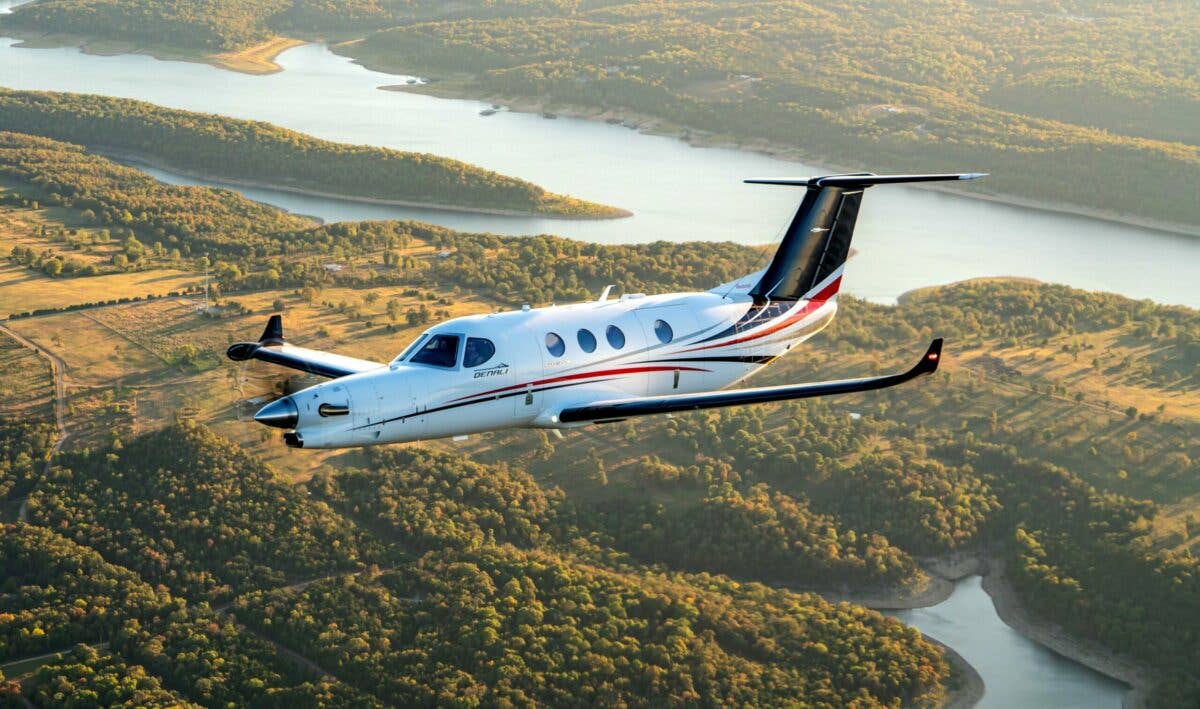Beechcraft Denali Gets Garmin Autoland
The single-engine turboprop still under development from Textron Aviation will come with the emergency protocol standard.

The Beechcraft Denali features the new, yet-to-be certificated GE Catalyst powerplant. [Courtesy: Textron Aviation]
When it debuts in 2025, the Beechcraft Denali will join the ranks of other single-engine turboprop and turbine aircraft in the class with Garmin’s Autoland emergency protocol standard.
In an announcement made during Textron Aviation’s media event on Thursday, May 4, Lannie O’Bannion, senior vice president of sales and flight operations, joined program managers from GE, and Dan Lind, senior director of sales and marketing for Garmin Aviation, to update on the development of the clean-sheet design—and reveal the news.
“You’ve heard us talk repeatedly about our product development strategy, which includes both clean-sheet designed aircraft,” as well as updates to popular models, said O’Bannion. “Because we’re aligning the aircraft with the certification of GE’s certification timeline, we’re now expecting the Denali to be certified in 2025. I’m also excited today to announce that we’ll be adding the ‘peace-of-mind’ technology to the Beechcraft Denali cockpit with the Garmin emergency Autoland system."
Autoland is the world’s first certified system of its kind for general aviation aircraft, with the ability to activate during an emergency situation and autonomously control the aircraft and land it without pilot intervention. Textron Aviation took customer feedback into account when determining the inclusion of Autoland in the Denali.
Paul Corkery, program manager for GE Aerospace Turboprops gave an update on the powerplant’s progress through certification and testing on the Denali airframe. “It’s running great. We’re getting up to 20 percent better fuel burn and ten percent higher power in cruise,” said Corkey. “We have a 16 to 1 pressure ratio” rather than the 10 to 1 or 11 to 1 ratio typical for engines in the class. “The first two stages of the compressor have variable geometry,” said Corkery. Plus, “we’re running hotter so we have cooled turbine blades—all that gives us that performance” driven by technologies that have trickled down from GE Aerospace’s “big engine” experience.
Textron Aviation and GE have logged more than 5,400 hours in engine testing using the Catalyst engines on the stand, and on the Denali airframe and previous platforms. GE has built a total of 26 Catalysts so far, and Corkery reported they were “75 percent of the way though the test plan.” Certification on the engine is now projected to come in late 2024—setting the stage for Denali’s debut the next year.
In total, flight test has logged more than 540 flights across three test aircraft, with takeoff and landing performance tests one of the sections recently completed.
Adding Autoland
FADEC is integrated into the powerplant development—and this allows for the autothrottle implementation from the aircraft’’s debut. And, it paves the way for Garmin’s Autoland functionality, which requires an autothrottle in order to execute the emergency descent, approach, and landing process.
Dustin Smisor, chief test pilot for Textron Aviation on the Denali flight test program, explained more about the flight testing already conducted using the Autoland system. Along with more than 1,300 hours of flight testing in both extreme hot and cold conditions, Smisor noted, “We robustly tested the avionics, autopilot, the autothrottle, the environmental control system—I talked about the ice protection system—and really importantly, the engine.
“We as test pilots go above and beyond what normal pilots would do in the course of flying,” said Smisor. “We take the airplane to extremes—really what people would consider abusive kinds of tests,” including lots of in-flight shutdowns and slamming the power up and down. “Every day we’re seeing in flight this fuel efficiency,” he added. “As a test pilot, I’ve kind of had to re-gauge myself because it just doesn’t burn very much fuel.”
As for Autoland testing? “The maturity that we already have in Denali even with the early stages of flight testing is pretty remarkable,” he said. “I personally was on the third flight of testing the Autoland, and we went out to Colorado, got behind Pike’s Peak, and activated the button” to see how it would do around mountainous terrain.
More Engine Details
Chris Lorence, chief engineer on the program for GE Aerospace, said of the comprehensive test program, “It’s a very rigorous approach, but it’s taking a lot of capacity to go do it. We’re almost three-quarters of the way through our test plan—we’ve got six more engine tests and eleven more certification component tests to get through before we’re complete.”
The test program has also put more than 3,400 hours on the McCauley propeller that will be paired with the Catalyst on the Denali. The program also recently checked off the additional maintenance interval inspection tests, where engineers run the engine and then tear it down to inspect components for wear. “One of the areas we always look for when we do these tests is looking at the hot section,” said Lorence. “We’re very pleased with how those parts look.
“It gives you a very jet-like experience,” said Smisor. “Even getting in up front, just the simplicity of the layout, the single-power lever, not very many switches, very integrated, automated tests—it just gives you a jet-like experience. It’s a lot of fun to fly.”

Sign-up for newsletters & special offers!
Get the latest FLYING stories & special offers delivered directly to your inbox






